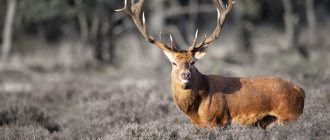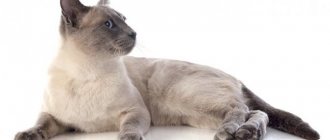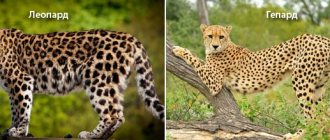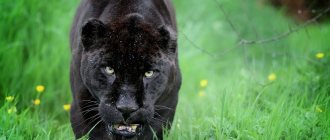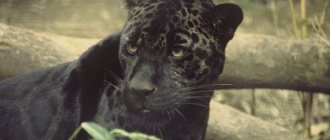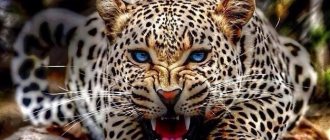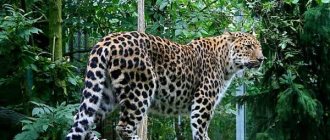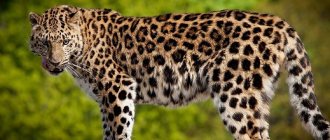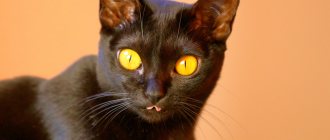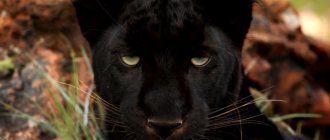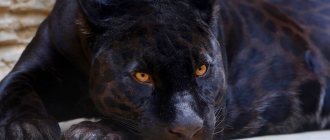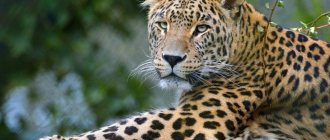- Panther: description, structure, characteristics. What does a panther look like?
In fact, the word “panther” hides not a separate biological species, but an entire genus of the cat family, which includes such formidable predators as the lion,
tiger, jaguar and leopard. As for the well-known black panther, it is usually a leopard or jaguar, which has a corresponding black color.
Why is the panther black?
The panther's black coloring is caused by special mutations in the animal's genes known as melanism. Such a mutation is very common among predatory felines, for example, in Malaysia, approximately half of all leopards there are black in color as a result of melanism and, in fact, are black panthers.
The black color of these animals often has practical significance (after all, nature is always wise in its actions), so many black panthers live in dense forests, where, with a lack of lighting, dark animals are less noticeable, which makes their life much easier.
conclusions
The animals in question have a number of differences:
- The term "panther" is broader. This is due to the fact that, in fact, the jaguar is a type of panther.
- Animals differ in coat color. Panthers have a black tint. At the same time, the jaguar has a wheat-brown color.
- Jaguars are considered faster animals and can reach speeds of up to 90 kilometers per hour. The maximum speed of panthers does not exceed 60 kilometers per hour.
- Jaguars mainly live in the Americas, while panthers are more common in the tropics.
Description, structure, characteristics
The calling card of any panther is its signature black color. Although if you look at the panther more closely, you will notice that its fur is covered with dark spots of different shades, all this creates the appearance of a black color.
Panthers are large predators; the weight of a panther can reach 40-50 kg. The body is oblong and reaches up to two meters in length.
The panther also has four powerful and large paws, with long and sharp claws that retract into the fingers (their structure is approximately the same as that of the kindest representative of the feline - the domestic
cats).
The panther's head is very large, somewhat elongated, with small ears on the top of the head. The panther's eyes are medium-sized with large pupils. The panther also has sharp teeth and powerful jaws.
The panther has fur all over its body and also has a very long tail, which can sometimes be up to half the length of the animal.
Nutrition
All panthers are ferocious and dangerous predators, one of the most dangerous among the cat family. If a panther is hungry, it can easily attack any nearby game, including humans. But most often the panther gets to eat various herbivores: zebras, buffalos, antelopes. Sometimes the panther is not averse to having a snack and
monkeys. Domestic animals: cows, sheep, horses, also finding themselves unattended in the jungle, have a high chance of becoming food for panthers.
Panthers always go hunting at night; in the dark, thanks to their black color, they become practically invisible, which gives them the opportunity to watch for potential prey without any problems.
Educational resource about culture, science and art
Author of the article: Sergey Kuriy Article from the “Cultural Zoology”
No wild cat has such a wide range as the leopard. This predator has successfully “mastered” a vast territory, including all of Africa (without the Sahara) and almost all of South Asia. At the same time, it feels great in the forest and in the mountains, and tolerates both heat and cold equally well. In the north, the leopard reached Transcaucasia and Primorye. True, it is no longer found in the Caucasus, but the Far Eastern leopard was seen quite recently. On July 24, 2016, a rare animal boldly ran across the highway in the Khasansky district of Primorye, and a little later it was still hit by a car.
In addition, on the other side of the globe, the leopard’s closest relative, the jaguar, lives. They are so similar that the inexperienced eye will not immediately determine who is in front of him - a resident of the Old World or the New? However, it is quite possible to distinguish them. In simple terms, the leopard is more graceful and “slimmer” than the stockier and densely built “American”.
Leopard.
The jaguar's legs are shorter and more powerful, the rosette spots are larger and more shaped, and the head is more massive and large (the Brazilians call it “kangu” - that is, “big head”).
Jaguar.
The beautiful skin of these predators was a coveted object of fashionistas of the 1930s-70s (Jacqueline Kennedy and Gina Lollobrigida loved to show off in “leopard” outfits). But even without this, people had enough reasons to kill leopards.
More dangerous than a tiger and a lion
Hunters unanimously argued that a leopard is more dangerous than a lion or a tiger, and that it is much more difficult to track and shoot it. The fact is that it is smaller and lighter than its “colleagues” (the leopard’s body length is 91-180 m, and its weight is from 30 to 90 kg). Consequently, it is more dexterous and invisible in grass, bushes or tree branches (spots on a yellowish background in these conditions are an excellent camouflage). They write that this predator can sneak up on an unsuspecting victim at a distance of up to 2 meters before making a lethal jump.
R. Kipling “How the leopard got his spots”: “- Become spotted like a giraffe. - For what? - Just think how profitable this is. Or maybe you prefer stripes like a zebra? Both the zebra and giraffe are very happy with their new patterns. - Hm! - said the leopard. “I don’t want to look like a zebra at all.” “Make your decision quickly,” the Ethiopian insisted. “I wouldn’t like to go hunting without you, but willy-nilly I’ll have to if you look like a sunflower against a dark fence.” “Well, I choose spots,” said the leopard. - Just don't make them too big. I don't want to look like a giraffe."
A. Brem “Animal Life”: “In appearance, the leopard is, without a doubt, the most perfect of all cats on the globe. Of the entire family of the latter, the lion, of course, inspires us with respect for its greatness, and we willingly recognize him as the king of beasts; the tiger is the most terrible representative of the ferocious cat society; The ocelot's fur is, of course, more colorful and colorful than the fur of other pardels; but in terms of slenderness of build, beauty and pattern of fur, and in terms of grace and beauty in movements, these cats, like all others, are far inferior to the leopard.”
The leopard is not only dexterous and sharp, but also silent. Of course, he can rumble dully and loudly and even roar (during the mating period), but not when hunting. They say that the leopard is silent, like a guerrilla, even when caught in a trap or wounded. It is interesting that such caution of the leopard and its reluctance to engage in “open battle” allowed Aristotle to rank this predator among the top most cowardly animals - along with the mouse, rabbit, hyena and donkey. However, residents of Africa and Asia, who are familiar with the leopard first-hand, never shared the assessments of the ancient Greek philosopher. For them, the leopard is a respected animal, a symbol of military valor and royal power (in Dahomey, local kings called themselves “children of the leopard”).
A. Brem “The Life of Animals”: “With such ferocity and dexterity of the leopard, it is understandable why among the Kaffirs the winner of a dangerous animal is held in such esteem. Dressed in a “carros” made of leopard skin, with a necklace of the beast’s teeth around his neck and his tail on his belt, the brave man looks down on his comrades, on whose belts only modest monkey tails dangle sadly.”
However, Aristotle’s opinion did not take root in Europe either. Yes, the leopard could be a symbol of anger and ferocity, but in no case cowardice. It is with the leopard (leopard) that the terrible “Beast emerging from the sea” is compared in the “Apocalypse” (13:1-2). It is the leopard, the wolf and the lion that pursue the hero of Dante’s “Divine Comedy” on the way to Hell. And a German tank won’t just be called a “leopard”.
As I already wrote, the leopard is good at adapting to different habitats, which helped it avoid the mass extermination to which lions and tigers were subjected. However, the favorite patrimony of this predator is, of course, the forest. The leopard excels at climbing and jumping in trees, which horrifies the monkeys. He often hides the remains of his prey in trees.
The same can be said about the jaguar. In the Guarani Indian language, the name “yaguara” has a very eloquent meaning: “a beast that kills with one leap.” When jumping, this predator is really fast, but, like most cats, it quickly runs out of steam over long distances (do the creators of the Jaguar sports car know about this?).
A. Milne “Winnie the Pooh and All-All-All”: “What are the Jagulars doing? - asked Piglet, hoping in his heart that they wouldn’t do this now. “They hide on tree branches and from there they rush at you when you are standing under a tree,” said Pooh... “Then we’d better not go near that tree, Pooh, otherwise he’ll rush out of there and get hurt.” “They don’t hurt themselves,” said Pooh, “they’re great at throwing themselves.”
Mine Reid “The Headless Horseman”: “Climbing the tree was useless: the jaguar climbs trees like a cat. Mustanger knew this. ...Purely by instinct, he rushed straight into the stream and stopped only when the water reached his waist. If Maurice could reason, he would understand that it is useless - after all, the jaguar not only climbs trees like a cat, but also swims like an otter. He is just as dangerous in the water as he is on land.”
Indeed, the jaguar is an excellent swimmer who manages to successfully hunt even caimans. However, the favorite food of this predator is the South American peccary pig (emphasis on the second syllable) and the world's largest rodents - capybaras, resembling a guinea pig one and a half meters long. In the New World, the jaguar is undoubtedly the largest and most dangerous predator, which the newly arrived Spaniards immediately nicknamed “El Tigro.” Of course, the jaguar was also revered by the Indians. Among the monuments of the Peruvian Chavin culture, stone figures of gods in the form of half-humans, half-jaguars have been preserved.
On the left is a jaguar figurine from Monte Alban (200 BC); on the right is an image of an Aztec warrior in a jaguar skin.
True, in South American fairy tales, the jaguar often plays the same role as the wolf in Russian fairy tales - it appears in the form of a formidable but simple-minded predator, led by the nose by an opossum or a monkey. You can also recall Kipling’s fairy tale “Where Armadillos Come From,” where a baby jaguar is “bred” by a hedgehog and a turtle. By the way, the advice of his jaguar mother - to scratch the turtle out of its shell - is not so fabulous - predators often use this technique in real life.
Previously, the habitat of jaguars was not limited to the South American jungle and reached states such as Texas, Arizona, New Mexico and California (it is in Texas that the action of the novel “The Headless Horseman” takes place). However, this predator has not been seen in the United States since the 1940s, although it is still found in some places in Mexico.
What does a panther smell like?
“I also love the black panther, When it looks in front of it into some non-life sphere, Like a terrible sphinx in the blue desert.” (F. Garcia Lorca)
As soon as I became interested in the origin of the name “leopard,” confusion quickly arose in my head. Perhaps more knowledgeable specialists will correct me - I came across too many contradictory hypotheses while researching this issue.
You don’t need to have deep linguistic knowledge to see the word “leo” in the name of a leopard - i.e. "a lion". But how is the second part translated - “pard” - more precisely, “pardus”? The English-language Wikipedia says that this ancient Greek word means “male panther” and is drawn from the eastern - Indo-Iranian - languages. Then who is this “panther”?
Panther Bagheera in the Soviet film "Mowgli".
Russian-speaking readers will find this question easy to answer. Many will immediately remember the unforgettable Bagheera from Mowgli, and those who are well-read will explain that the panther is not a separate species, but simply a genetic variety of black leopards. Black individuals (in science called melanists) are also found in jaguars, but such individuals have not yet been found in lions and tigers.
By the way, in Kipling’s original Bagheera is not a female, but a male. Disney took a lot of liberties with his adaptation of The Jungle Book, but he got the panther's gender correct.
The coloring pigment melanin is to blame for excessively dark coloring - the same one that is responsible for the color of our hair, the color of the iris, etc. It is its enhanced formation under the influence of UV rays that manifests itself on human skin in the form of tanning and freckles.
The first of the medieval Europeans to describe the black leopard, so to speak, “from nature,” was Marco Polo. This 13th century traveler managed to get all the way to China. True, in his descriptions Polo calls the panther a “lion.”
“There are many different animals here; They are not like animals from other countries. There are completely black lions here without any markings.”
However, look at what Ovid writes in Metamorphoses:
...God (meaning Bacchus - S.K.), meanwhile, having crowned his forehead with clusters of vines, Himself shakes a spear entwined with vine leaves. Tigers are around the deity: ghosts of lynxes appear, Wild ones immediately lay down with the spotted skin of a panther...
The Roman god of wine, Dionysus, rides a leopard.
And here is what Mephistopheles says in Goethe’s Faust, addressing the freckled blonde:
"My soul! With such whiteness, being spotted like a panther for six months can ruin a woman’s career.”
Indeed, even on the blackest panther, spots always appear. E. Ji wrote in “Wild Animals of India” that there are even special “underpanthers” in which black spots are clearly visible on a light chocolate background. It is not for nothing that in English the analogue of our proverb “Only the grave will correct a hunchback” sounds like “Can a leopard change its spots?” (“Can a leopard change its spots?”).
“The Book of the Prophet Jeremiah” (13:23): “Can an Ethiopian change his skin and a leopard his spots? So can you do good if you are accustomed to doing evil?”
Women in leopard print dresses. On the left is a painting by C. E. Perugini. On the right is Italian actress Marie-Angella Melato.
R. Kipling “Mowgli”: “A black shadow lay in the middle of the circle. It was Bagheera, a black panther, completely black, like ink, but with marks that, like all panthers, are visible in the light, like a light pattern on a moiré.”
If anyone didn’t read the book carefully, then in the Soviet cartoon “Mowgli” the competent creators clearly indicated Bagheera’s species when they depicted her running with a spotted leopard during the mating season. The cubs in such a family can be very different - both spotted and black. But the latter is less common because the black color gene is recessive and is often suppressed by the spotted gene. To get 100% black offspring, you need two black panthers, but “negros” can also be born to spotted parents if their ancestors included blacks. Apart from color, spotted leopards and panthers are no different from each other.
However, the spectacular image of the panther (a black cat with glowing eyes) made the panther a real symbol of a formidable, beautiful, dexterous, treacherous (and sometimes treacherous) woman (the song “Agatha Christie” and the film about the werewolf girl “People” immediately come to mind -cats" with Nastassja Kinski).
Nastassja Kinski with her “alter ego”.
True, the Nazis managed to give this name to a rather square (but still formidable) tank. On the coat of arms of the African country of Gabon, two panthers hold a shield and personify (I quote) “the vigilance and courage of the head of the Gabonese state.”
A radical nationalist black group is widely known as the Black Panthers.
As you can see, in the West an ordinary leopard can be called a “panther”, and for melanists they will definitely add the epithet “black” - “black panther”.
However, all this does not clarify the above statement from Wikipedia that “pardus” means “male panther”. In this case, it turns out to be nonsense - “leopardus” turns out to be a hybrid of “lion” and... the same “leopard”! However, there are more logical interpretations. For example, the assumption that the words “panther” and “pardus” are derivatives of the Sanskrit “pundarikas” (tiger), which, in turn, comes from pandarah - “light yellow”. And in the article “tiger” from Dahl’s dictionary we can find the following phrase: “the scientific name of the beast Pardus.” That is, in ancient times the “leopard” was perceived as a kind of cross between a lion and a tiger...
With the third name of the leopard - “leopard” - things are not so confusing. It is believed to come from the word “prassum” from the Hittite language (the supposed ancestor of the Abkhazian and Adyghe languages). In our country it took root in the 16th century and meant, first of all, Caucasian leopards. Although it was also used against other large and spotted animals - like the cheetah or the snow leopard (the latter would eventually be called the “snow leopard”).
But let’s return to the word “panther”, the origin of which is also not clear. In ancient times it was interpreted more simply, without delving into Sanskrit. Like, “pan” is Greek for “everything, universal,” and “theros” is “beast.” That is, the “panther” is a kind of “all-beast” - a beast above all animals.
Isidore of Seville: “The Panther is called by this name either because he is a friend to all animals except the dragon, or because he likes the community of his kind, and what he receives he returns with equal sameness.”
Such a strange interpretation will become clear if we recall one ancient (and no less strange) idea about this animal. Even in the ancient world, it was believed that the panther (then called “purd”) was capable of exuding a fragrant and enchanting aroma that no animal could resist. It is not without reason that the ancient Greeks used the word “pardalis” not only to refer to leopards, but also to hetaera - professional “priestesses of love” who generously anoint themselves with incense.
Aristotle, “History of Animals”: “They also say that the pard, knowing that its smell is pleasant to animals, hunts, hiding itself: it comes close and thus captures even deer.”
If there was at least some pragmatic logic in this description, then it disappeared in the Christian era. In theological presentation, the predator already exudes a scent just like that, without pursuing any insidious gain.
“Physiologist” (II-III century): “In her sleep she exudes a fragrance, and at this smell all the other animals gather around her, and rejoice at the aroma, and having had enough of it, they disperse in joy and contentment through the thickets and fields.”
The panther attracts all the animals, but frightens the dragon, which is hiding in a hole. Drawing from the “Bestiary” (XII century).
At first, this smell was compared to the Word of Christ, attracting the souls of people to faith. In courtly culture, the Beautiful Lady began to be compared with a fragrant panther.
“Bestiary of Love in Rhymes”, unknown poet of the 13th century: I follow her like animals follow a panther. I followed her and follow her, accompanying the lady. The beloved attracts, beckons, intoxicates with her sweet breath. Colored in all colors, the Panther is more beautiful than all animals. It enchants with its beautiful appearance. Having woken up, the thunderous cry of the Animal delights the ear, And the indescribably sweet spirit of the forest fills the thickets, And there is no sweeter fragrance. The animals like this smell. Only the snake is afraid of him, He is saved, as if from a chase, From these heavenly incense. But everyone, except the snake, is glad to Inhale the wonderful aroma, And therefore other animals Always accompany the panther...
J. Boschius, “Decoration is created by spots.” 1702
But in Gustav Meyrink’s mystical novel “The Angel of the Western Window” the insidious seductress is already associated with the panther.
“The naked princess with the most natural appearance came out of her mother-of-pearl shell. Her wonderful, immaculately proportioned body of a light bronze hue, which retained its chaste elasticity, even next to the stone Isais, looked like a real masterpiece. The dress thrown on the floor exuded a predatory aroma, or so it seemed to me; this well-known, nerve-tickling smell of a panther in my already overexcited state was simply deafening.”
If in medieval Europe ideas about leopards were very abstract (after all, they were not found there), then in Meyrink’s time they already knew very well how dangerous this predator was.
But I will devote a separate article to cannibals in the cat family.
Author of the article: Sergey Kuriy August 2016
Lifestyle
Panthers, like real representatives of the cat family, are true individualists, preferring to live alone, or in pairs of male + female. Occasionally they can gather in a pride, as lions do, creating a small family of panthers, but this does not happen often.
Panthers are territorial animals; each panther has its own specific territory, so to speak, hunting grounds, where it is not advisable for other panthers to enter.
Panthers are nocturnal, which is greatly facilitated by their black color, thanks to which night hunting is much more preferable for a panther than chasing game during the day.
Reproduction
Panthers reach sexual maturity by 2-3 years. And since they live in a constantly warm climate, they can reproduce all year round. The male, having found a suitable female, has sexual intercourse with her. Having become pregnant, the female looks for a safe and comfortable place to give birth.
The pregnancy itself in a female panther lasts 3-3.5 months. Usually, a panther gives birth to two or three small kittens (well, not really kittens), like the babies of an ordinary cat, at first they are blind, and only then their eyes appear. At first, mother panther does not leave her babies, feeding them milk, while dad, like a real breadwinner, brings food.
In general, panthers are very caring towards their offspring, and at an older age, the mother panther teaches her cubs how to move correctly, hunt and other intricacies of their animal life. When a panther reaches a year, it already becomes a fully grown animal ready for independent life.
Hybrid of jaguar and leopard
Under natural conditions, the emergence of hybrids between these species is impossible due to different habitats and the impossibility of free mating.
Thanks to human activity, leopards and jaguars were able to interbreed and have offspring. According to accepted terminology, the name of a hybrid begins with the name of the species of the male animal that acted as the parent. Accordingly, the berry pard is a hybrid of a male jaguar with a female leopard, and the leguar is a hybrid of a male leopard with a female jaguar.
The phenotype of hybrids includes specific characteristics of both parents. Hybrids are often stockier than leopards, with relatively thick and short legs and necks. Their coat is usually golden-orange in color, although it can be auburn, olive, steel gray or taupe. The spots in the chest area are less pronounced. It has been noted that berry parrots are more trainable than their parent species.
Interestingly, hybrid females can interbreed with male lions, producing offspring.
1111
Video
And in conclusion, an interesting documentary video about a black panther/leopard.
Author: Pavel Chaika, editor-in-chief of Poznavaika magazine
When writing the article, I tried to make it as interesting, useful and high-quality as possible. I would be grateful for any feedback and constructive criticism in the form of comments on the article. You can also write your wish/question/suggestion to my email [email protected] or Facebook, with respect, the author.
Author page
This article is available in English -
Black Panther Animal.
